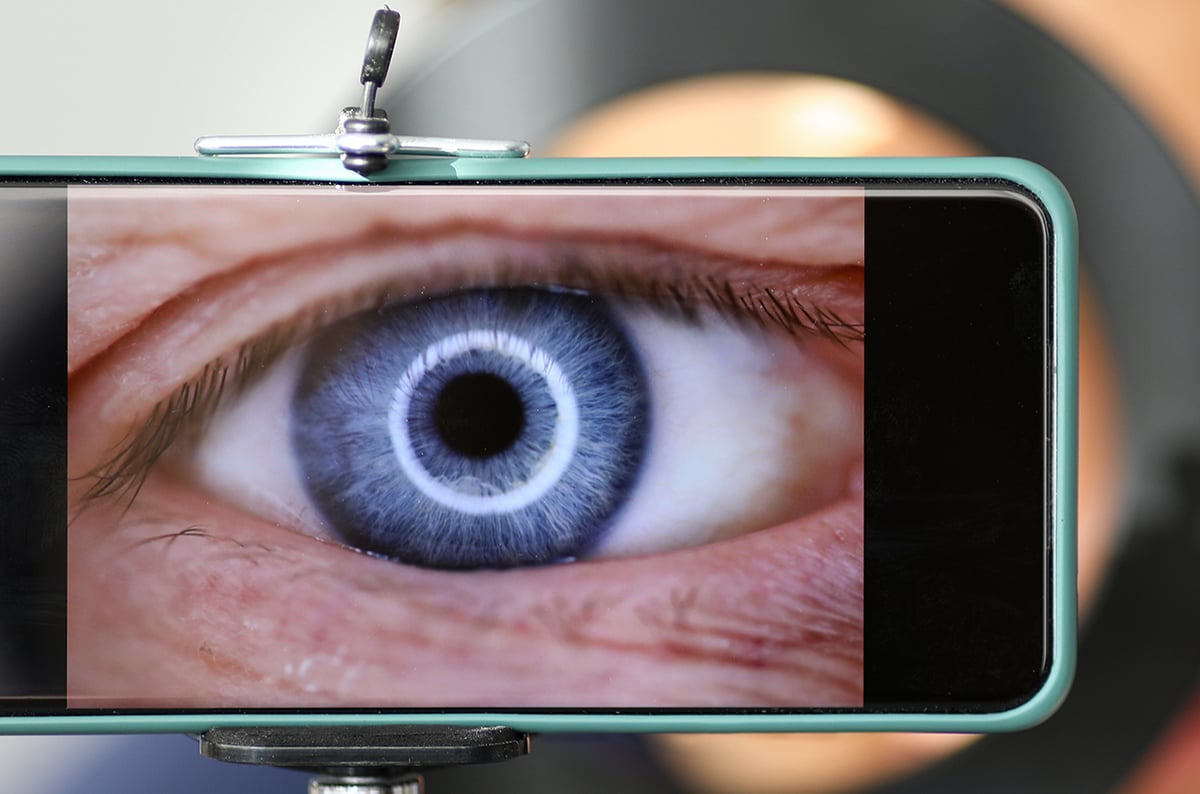Watch for Keratoconus at All Ages
Hot Topic
In a recent study published in Cornea, researchers in Turkey investigated the progression of keratoconus (KC), a corneal ectasia that can significantly impair quality of life. The study analyzed 949 eyes from 503 patients with at least 1 year of follow-up and three or more Pentacam (Oculus Optikgeräte) Scheimpflug tomography imaging scans. Patients were divided into five age groups: younger than 18, 18-24, 25-30, 31-35, and older than 35 years of age, with disease severity classified using the topographic KC classification (TKC) system—subclinical, early-stage (TKC 1-2), or advanced-stage (TKC 3-4). The findings revealed that KC progression rates decline with age, with the highest rate observed in patients 18 years of age or younger (86.4%) and a notably lower progression rate of 44.3% in those 35 years of age or older. Advanced-stage disease (TKC 3-4) significantly increased progression risk across all ages, particularly in the oldest group, where it was associated with a 10- to 20-fold higher risk. The median time-to-progression was shortest in the youngest group (8.6 months for TKC 1-2 and 5.8 months for TKC 3-4) compared with 18.9 months for advanced-stage and 38.2 months for early-stage disease for those 35 years of age or older. Overall, 55.3% of cases progressed, with similar rates between men (56.1%) and women (54.3%). Bilateral progression was most common in those younger than 18 years of age (50%). The highest progression rate (91.7%) was seen in patients who were 18 years of age or younger with advanced disease. The study emphasizes that advanced-stage KC is a significant risk factor for progression, even in older patients, underscoring the need for age-tailored risk stratification and timely interventions, such as corneal crosslinking, to manage progression while avoiding overtreatment in stable cases.
My Two Cents
The most significant finding from this study is that 44% of KC patients over 35 years of age are still progressing. This surprisingly high number is something we need to keep in mind. Personally, I regularly see patients in our clinic who are in their 50s and still progressing. We do quite a few corneal crosslinking procedures at our clinic, and our referral network for the procedure has grown dramatically in recent years.
In other (undeniable) data, the report also emphasizes that the KC progression rates were found to decline significantly with age, and the shortest time-to-progression was seen in those 18 years of age and younger. So, another friendly reminder to get our patients who have KC (and other corneal ectasias) crosslinked ASAP!

OUTSIDE THE LANE
Washington Aims to Reign in Pharmaceutical Ads
On September 9, 2025, President Donald Trump signed a memorandum to enhance oversight of direct-to-consumer (DTC) prescription drug advertising, stopping short of the complete ban proposed by Health and Human Services Secretary Robert F. Kennedy Jr., who has criticized such ads for increasing medication use. The memorandum, as reported by NBC News, targets not only traditional TV ads but also social media and digital platforms, aiming to ensure transparency and accuracy by requiring more comprehensive disclosure of drug risks. The Trump administration plans to enforce existing regulations by issuing approximately 100 cease-and-desist letters and thousands of warning letters to pharmaceutical companies, online pharmacies, social media platforms, and influencers failing to disclose paid promotions or adhere to advertising rules. A senior official highlighted public frustration with misleading ads, particularly those on social media that omit side effect information, citing a Hims & Hers Super Bowl ad as an example. The initiative also seeks to close a 1997 FDA loophole allowing minimal side effect disclosures in ads if linked to fuller information elsewhere, which spurred a surge in DTC advertising. Enforcement has been lax in recent years, with the FDA issuing fewer warnings, prompting this renewed focus driven by physician concerns about distorted patient relationships. The memorandum aligns with a report from Trump’s “Make America Healthy Again” commission, emphasizing stricter oversight by the Health and Human Services, FDA, Federal Trade Commission, and Department of Justice, with a priority on violations that cause harm. This follows Trump’s earlier, unsuccessful 2019 attempt to mandate list price inclusion in TV ads, which was blocked by a federal judge. With more than $10 billion spent on DTC ads in 2024, this move could significantly affect the pharmaceutical industry’s marketing practices.
My Two Cents
Politics aside…this is (seemingly) a great move by the current administration. I can’t tell you the number of times I’ve watched a DTC ad for a cardiovascular, eczema, psoriasis, or other product and wondered if that advertisement actually makes patients demand that their doctors prescribe that very medication.
From a dry eye disease standpoint, I can honestly tell you that I don’t mind DTC ads for dry eye patients because they start the conversation about the disease process and some of the treatment options available beyond artificial tears. Personally, I can’t help but wonder if pharmaceutical ads could be altered to focus more on the disease processes themselves rather than the specific medications used to treat them. Similarly, many pharma brands create educational content directed at practitioners about the disease process and the proposed mechanism of action of the drug they are marketing. Regardless of who introduced this piece of legislation, it is likely to affect every American, as well our perception of how our friends in the industry are allocating their marketing dollars.

CAN YOU RELATE
I can’t open my browser or check my email anymore without stumbling across an announcement from a company either in the eye care space or looking to get into the space to use the eye’s biomarkers as a measure for some unit of systemic health. For example, on September 9, Topcon Healthcare announced that it is making a strategic investment in Senseye, a company developing a mental health diagnostic platform using ocular biomarkers.
According to Topcon, Senseye’s technology uses AI and computer vision to analyze pupillary dynamics and eye movements captured via a smartphone camera. These signals are then translated into various validated digital biomarkers to support the diagnosis and monitoring of posttraumatic stress disorder, major depressive disorder, and generalized anxiety disorder.
Unlike conventional mental health evaluations that typically rely on subjective questionnaires, Senseye offers an objective and noninvasive alternative. Ali Tafreshi, CEO and president of Topcon Healthcare, affirms this by stating, “Their work exemplifies our ‘Healthcare From the Eye’ vision, expanding the role of ocular data beyond eye and systemic disease into psychiatry.”
For those keeping score at home, that adds psychiatric issues to the list of health concerns our eye examinations may be able to discover. It joins Alzheimer’s disease and various cardiovascular problems, which I have previously profiled in this newsletter.
What does that really mean for you and me? Well, I can’t scroll through the various optometry social media groups without seeing all the doom and gloom of our profession, especially when it comes to contact lenses and online glasses sales. However, where one window closes, a door may open, and it’s becoming abundantly clear that a massive set of double doors is opening for ODs to become more ingrained in the overall health of our patients. Topcon’s push for Healthcare from the Eye may be a cheesy catchphrase, but it’s one that I believe we should all be making a concerted effort to achieve. Congrats to Topcon on what appears to be a great move!

QUOTE OF THE WEEK
“These drug ads are genius! They show happy people frolicking in fields while a voice whispers, ‘May cause sudden death, rectal bleeding, or an urge to gamble away your house.’”
— Stephen Colbert
Ready to Claim Your Credits?
You have attempts to pass this post-test. Take your time and review carefully before submitting.
Good luck!
Recommended
- Significant Findings
Cycloplegic Refraction Shows Benefit Over Non-Cycloplegic Tools
Josh Davidson, OD, FSLS, FAAOJosh Davidson, OD, FSLS, FAAO - Significant Findings
Opposition Mounts Against Tariffs on Optical Products
Josh Davidson, OD, FSLS, FAAOJosh Davidson, OD, FSLS, FAAO



